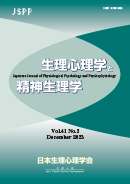Current issue
Displaying 1-10 of 10 articles from this issue
- |<
- <
- 1
- >
- >|
-
2023 Volume 41 Issue 2 Pages 117-119
Published: December 31, 2023
Released on J-STAGE: March 20, 2024
Advance online publication: January 17, 2024Download PDF (422K)
-
2023 Volume 41 Issue 2 Pages 120-131
Published: December 31, 2023
Released on J-STAGE: March 20, 2024
Advance online publication: June 24, 2023Download PDF (675K) -
2023 Volume 41 Issue 2 Pages 132-140
Published: December 31, 2023
Released on J-STAGE: March 20, 2024
Advance online publication: September 09, 2023Download PDF (764K) -
2023 Volume 41 Issue 2 Pages 141-153
Published: December 31, 2023
Released on J-STAGE: March 20, 2024
Advance online publication: January 13, 2024Download PDF (840K)
-
2023 Volume 41 Issue 2 Pages 154-161
Published: December 31, 2023
Released on J-STAGE: March 20, 2024
Advance online publication: November 02, 2023Download PDF (631K) -
2023 Volume 41 Issue 2 Pages 162-171
Published: December 31, 2023
Released on J-STAGE: March 20, 2024
Advance online publication: December 01, 2023Download PDF (757K)
-
2023 Volume 41 Issue 2 Pages 172-183
Published: December 31, 2023
Released on J-STAGE: March 20, 2024
Advance online publication: August 03, 2023Download PDF (609K)
-
2023 Volume 41 Issue 2 Pages 184-196
Published: December 31, 2023
Released on J-STAGE: March 20, 2024
Advance online publication: June 29, 2023Download PDF (1075K)
-
2023 Volume 41 Issue 2 Pages 197-201
Published: December 31, 2023
Released on J-STAGE: March 20, 2024
Advance online publication: December 22, 2023Download PDF (649K)
-
2023 Volume 41 Issue 2 Pages 202-210
Published: December 31, 2023
Released on J-STAGE: March 20, 2024
Advance online publication: July 07, 2023Download PDF (1102K)
- |<
- <
- 1
- >
- >|
